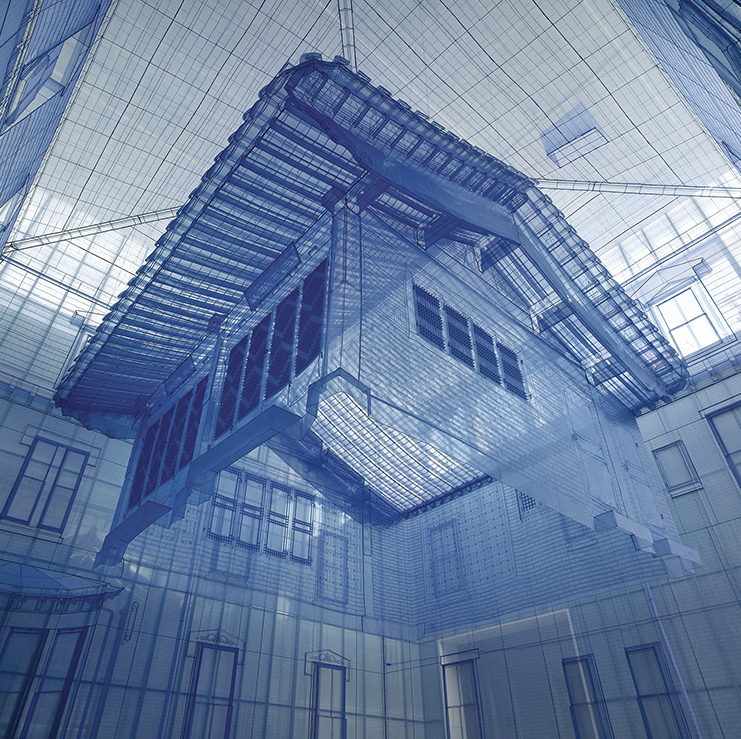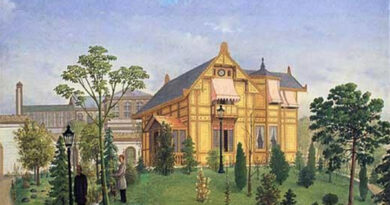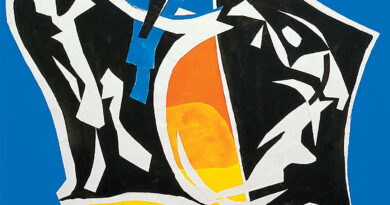do ho suh: the home as a symbolic locale of the diasporic experience
by MÜMTAZ SAĞLAM
With his work, Do Ho Suh actually develops emotional and scathing critiques, forged by his transient view of the fictional home, and its permeable sense of privacy. He thus renders the problem and the idea posed by the concept of the home with his spatial installations and his architectural know-how; and confronts the viewer with an uncanny, transient emptiness rendered in meticulous visual splendor. For this reason, Suh’s phantom home-image, with its elegance and lightness, is an entity of psychological space-time rather than a physical form. And it is amply public. Now, the home has become an unforgettable sacred space, a cultural temple of unprotected, unsettling, impossible depth.

Do Ho Suh, Home within Home within Home within Home within Home-2013, polyester-fabric-metal-frame-1530x1283x1297cm. [ https://archibat.com/blog/en/the-ghost-houses-of-do-ho-suh/ ]
Do Ho Suh is a Korean sculptor and artist, known from his fictional architectural structures built with his characteristic technique and visual language since 1998. These iconic, full-scale structures, enmeshed with transparent and graceful elements, represent a reality that visualizes the concept of home.[i] Suh’s approach can be summarized as a conceptual arrangement, or practice; that has been bolstered with metaphoric, symbolic and psychological references. His work can be likened to a playful, parodic design experience created to counter his sense of cultural alienation across different world cities.
the construction of transparent personal areas open to first person interior experiences
Do Ho Suh’s portable domestic arrangements are covered with plastics that resemble traditional embroidered cloth coverings native to his region. They suggest a lightweight, uncanny, and unnerving spatial experience that recalls the privacy of a house, or a room. This choice of material naturally creates a field of mental and emotional reality. Moreover, the artist’s installations, made by the successive joining of such locales, transform into sensory therapeutic experiences that contain a melancholic, almost phantasmal sense of sorrow.[ii]
Such paradoxes of perception, observed in Suh’s real-size, permeable conceptual locales doubtlessly gain new meaning when considered as part of the conflicting identity of the home as a conceptual structure. For this reason, the artist’s transformation of enclosed, yet visible and transparent spaces into novel, hybrid personal locations; must be considered as an act of conceptual re-shaping and re-arrangement.[iii] For truly, Suh’s conceptual domestic architecture possesses a transparency that makes one question the location’s purpose and the necessity of its existence. The installations nevertheless retain an objective consistency with their defined shapes and their metal-construction covering. Their purity and transparency hint at the loss of privacy, forgotten memories, and the passage of time. This sense becomes even more prominent in those installations with sequential and side-by-side location arrangements. These arrangements, which mimic homes and buildings, render an abstract sense of construction visible that priorities a narrative of difference. Thus, they present transparency as a visible outcome of mental chaos and other psychological stressors.
do ho suh / domestic elements and the home as a symbolic locale of the diasporic experience [iv]
On the other hand, the sense of privacy that the architecture of the transparent home cannot overshadow instead relates to the entirety of the work’s location and perception. For the home is a special place which houses and protects secrets under any condition. It is full of psychological or cultural status symbols that advance a certain way of life. It persists across all times and imaginings. With a traditional, modern or contemporary narrative, the home maintains its sense of mystery in interiors, and its definition of personal space.
Any effort made in order to penetrate its mysteries is bound to end up as an act of voyeuristic effort. But in the case of Suh’s work, the emptiness of interiors and the transparency of its walls, partially cancels such passionate gazes. The privilege to be able to simultaneously stand inside and outside of Suh’s work, seems to have pushed its secrets beyond its empty interior. Indeed, Suh’s sculptures of everyday objects, which we will study shortly, also exist in similar, liminal spaces.
Do Ho Suh, also re-makes replicas of household objects and architectural elements in the same material aesthetic sensibility. These transparent objects emerge as weightless and innuendo-ridden products of nuanced architectural sensibilities. Be they shaped like radiators, ovens, bathtubs or toilet seats, these everyday objects are re-produced with an extremely detailed, delicate and sensitive aesthetics based on the art of embroidery.
The resulting domestic arrangement of the house and its moveable domestic elements can also be likened to spiritual detailing, and stands out as a complementary, novel force in Suh’s rhetoric of imagery.[v] For this reason, Suh’s narrative is actually completed with the interpretation of these implied phantom shapes, in which he hides a wealth of ideas that conflict with the structural idea of a sound, solid structure. Rather than penetrating a sense of mystery, every revealed form stands before us with the uncanny assumptions of a holistic, personal design for a home/locale.
With his work, Do Ho Suh actually develops emotional and scathing critiques, forged by his transient view of the fictional home, and its permeable sense of privacy. He thus renders the problem and the idea posed by the concept of the home with his spatial installations and his architectural know-how; and confronts the viewer with an uncanny, transient emptiness rendered in meticulous visual splendor. For this reason, Suh’s phantom home-image, with its elegance and lightness, is an entity of psychological space-time rather than a physical form. And it is amply public. Now, the home has become an unforgettable sacred space, a cultural temple of unprotected, unsettling, impossible depth. (Translated by C. M. Kösemen)
Mümtaz Sağlam, Copyright © 2022 / All Rights Reserved
see: https://saglamart.com/do-ho-suh-home-an-area-for-declarations-of-identity-and-difference
[1] Do Ho Suh (b. 1962, Seoul, Korea; lives and works in London, United Kingdom) works across various media, creating drawings, film, and sculptural works that confront questions of home, physical space, displacement, memory, individuality, and collectivity. Suh is best known for his fabric sculptures that reconstruct to scale his former homes in Korea, Rhode Island, Berlin, London, and New York. Suh is interested in the malleability of space in both its physical and metaphorical forms, and examines how the body relates to, inhabits, and interacts with that space. He is particularly interested in domestic space and the way the concept of home can be articulated through architecture that has a specific location, form, and history. For Suh, the spaces we inhabit also contain psychological energy, and in his work he makes visible those markers of memories, personal experiences, and a sense of security, regardless of geographic location. [https://www.lehmannmaupin.com/artists/do-ho-suh/biography]
[ii] Sarah Newman, “Do Ho Suh”, Oz, Volume 40, Article 20, 2018. [ https://www.researchgate.net/publication/329395171_Do_Ho_Suh ] or [ https://newprairiepress.org/oz/vol40/iss1/20/ ]
[iii] Home within Home an installation where the viewer stays inside and outside at the same time or wanders under, includes a radical installation proposal. See. Do Ho Suh, Home within Home, 2013, Metal Construction and Polyester Fabric, 602.3×505.1×510.6 cm. [www.saic.edu.2018]
[iv] diasporic experience: the traumatic migration experience.
[v] See. “Present Specimens Series”, [https://designboom.com.2018]



